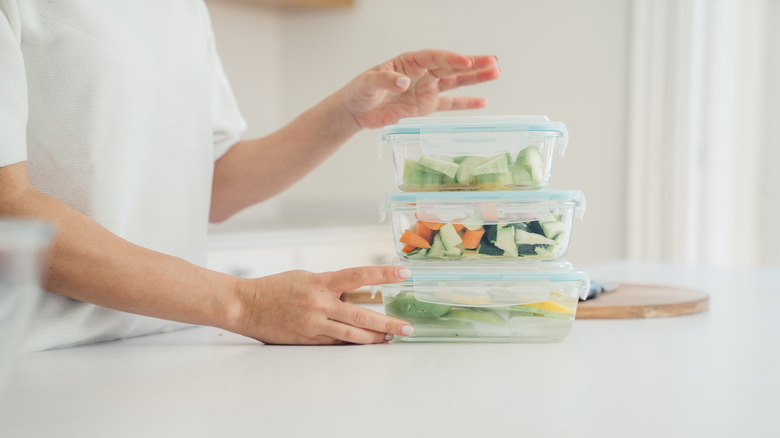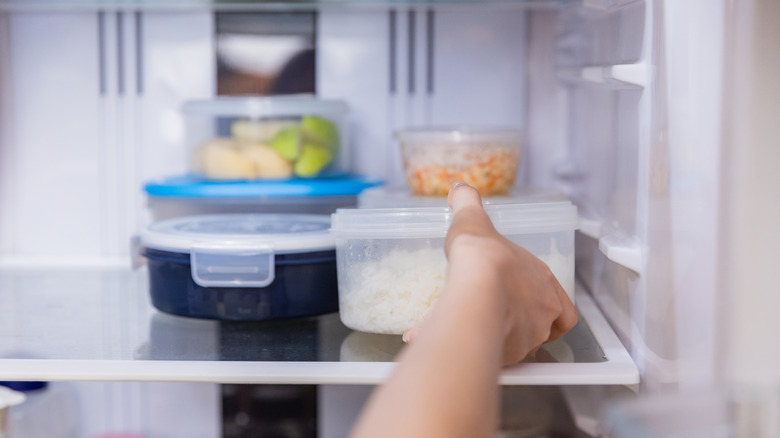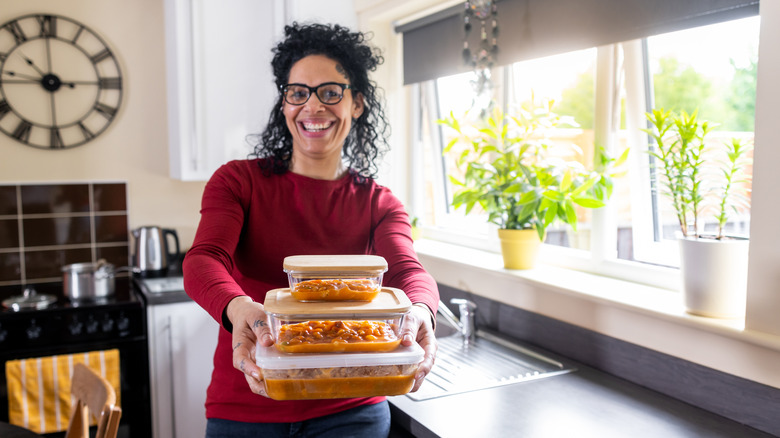Rid Your Tupperware Of Stains With An Easy Baking Soda Paste Hack
Food storage containers come in clutch when it's time to put away leftovers and meal prep for the week. But just like any tool you use in the kitchen daily, they're liable to go through some wear and tear. Your Tupperware may be susceptible to odors and stains over time, and if warm soapy water isn't getting the remnants of last week's chili out of your plastic lids and containers, it may be time to pull out some sodium bicarbonate or baking soda.
To remove pesky stains, try a deep cleaning hack by making a paste with baking soda and water. Spread the paste throughout the container and lid, and let the baking soda work its magic by leaving it for a couple of hours, then rinse away. The result will be stain-free Tupperware, and you're free to store things like tomato sauce, soups and stews again without worry. Baking soda is also excellent at removing odors, so your containers will additionally smell fresh and clean.
Why baking soda works, and how to keep plastic food containers stain-free
As an alkaline substance (albeit a gentler one), baking soda is a natural match for taking on greasy, oily food stains. This kind of grime tends to be acidic, so the sodium bicarbonate has a neutralizing effect, weakening it and making it that much easier to remove. The longer you let your Tupperware sit, the easier the stains will come off.
Of course, the best way to steer clear of stains is to thwart them in the first place. A simple solution is to coat your containers with cooking spray before adding food; you can also blanket them with a layer of foil or plastic wrap to create a barrier between the food and the container itself, keeping stains at bay.
It's also a good idea to double-check whether your Tupperware is dishwasher safe. While hand washing is the gentlest option for keeping your containers clean, the convenience of putting them in the dishwasher makes total sense — just be sure they're dishwasher approved. The dishwasher's heat can melt or warp the plastic, leaving you with wonky tops that no longer seal, so wash lids and containers on the top rack.
And, of course, timing is important, so be sure to clean your containers as soon as you're done using them. Immediately wash with soap and water, or if you're short on time, at least rinse away food before it hardens.
Other ways to tackle stained Tupperware
If you need to deep clean and happen to be out of baking soda, another method for getting out stains is with hand sanitizer. Pour enough liquid sanitizer into the container to completely cover any stains, and let it sit for about an hour. Then, pour the sanitizer down your sink drain or wipe away with a damp paper towel, and rinse the container. The stains should be rinsed away, or they may appear on the paper towel as you wipe up the sanitizer. Another option is to soak your Tupperware in a mix of bleach diluted with water. Try tossing two teaspoons of bleach into a gallon of water, followed by your stained containers, and let them soak for at least 30 minutes. Once it's time to take the containers out, be sure to rinse, wash and dry them thoroughly.
There is also the chance that baking soda, hand sanitizer, and even bleach won't get out stubborn stains. If that's the case, it may be time to invest in new ones. Tupperware isn't built to last a lifetime, but if you're looking for food containers with a bit more longevity, try glass storage containers instead. In addition to being more robust than plastic, glass containers aren't as susceptible to stains since they're made from non-porous material. However you decide to store your food, these simple cleaning tips will keep your containers in tip-top shape.


